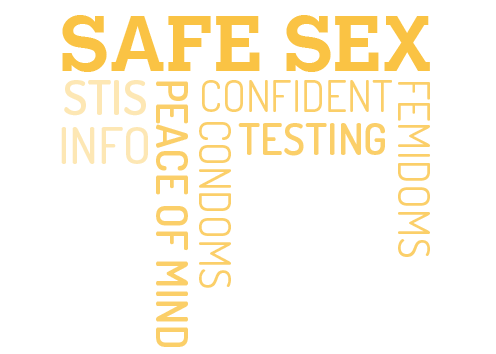Safer sex is a way of reducing the chance of getting or passing on a sexually transmitted infection (STI).
There are a number of different STIs including:
- Chlamydia
- Gonorrhoea
- HIV
- Syphilis
- Herpes
- Hepatitis A, B, and C
- Warts (human papilloma virus/HPV)
The risks of getting one of these STIs will be different depending on who you have sex with and the type of sex you have.
In the same way that there are different types of sex you can have and different risks of STIs there are also different ways in which you can have safer sex. You may find you need different safer sex options at different times of your life and many people find that a combination of different safer sex methods may be useful to protect your sexual health.

Types of safer sex
There are a number of ways you can have safer sex and reduce your risks of STIs:
- Using condoms for penetrative sex
- Having non-penetrative sex (such as mutual masturbation)
- Reducing the number of different sexual partners you have
- Getting tested for STIs with new sexual partners and agreeing to only have sex with each other
- Getting vaccinations for STIs like Hepatitis B or the human papilloma virus HPV.
- Taking PrEP to protect you from HIV (particularly if you are at high risk of HIV).
- If people living with HIV are on effective treatment, it also means they can’t pass on the virus to their partners.
Talking to a member of staff at Unity can help you find the right types of safer sex which work for you.
Condoms and lubricant
Condoms are the best way to reduce transmission of STIs and they can protect against pregnancy.
Condoms are:
- Free of side effects
- Easily used by anyone and without the help of a health worker.
Lubricant can make a big difference to condoms, from making them easier to use, reducing the chance of them breaking, or making sex feel more pleasurable for both partners.
Lubricant comes in different types. Water or silicon based lubricant is safe for use with all condoms, but be careful not to use an oil based lubricant or moisturiser with latex condoms, as they can cause the condoms to break.
For information on how to use a condom, click on the link below.
Some people can experience difficulties with using condoms, and the troubleshooting guide on the link below has some helpful hints on how you can overcome issues like losing erections or condoms breaking.

Choosing the right condoms and lube
There’s a huge variety of condoms and lube available, with differences in size and materials for condoms, and the types of lubricant that goes with them.
Choosing the right condoms and lube can make a big difference to how easy they are to use, improving sensation and pleasure during sex, and reducing the chance of condoms breaking.
Different types of condoms include:
- Male condoms (worn by the insertive partner, e.g on a penis or sex toy)
- Female condoms (worn by the receptive partner, e.g. inside the vagina or rectum)
- Different Sizes (usually based on how wide a penis or sex toy is, rather then length)
- Different Materials (including latex free options)
- Different Styles (ribbed, dotted, natural, ‘easy-on’, flavoured)
Lubricant that is safe for use with condoms comes in silicon, water based varieties, with some lubricants using a mix of both. Lubricants can be clear or opaque in colour, and come in different flavours too. The feel and sensation of lubricants can differ greatly between brands, so it’s a good idea to try different ones to help you find one that’s right for you.
Unity services provide a wide variety of free condoms and lube. Our friendly staff can help you find the best options which work for you, and help with any difficulties you may have using condoms.

